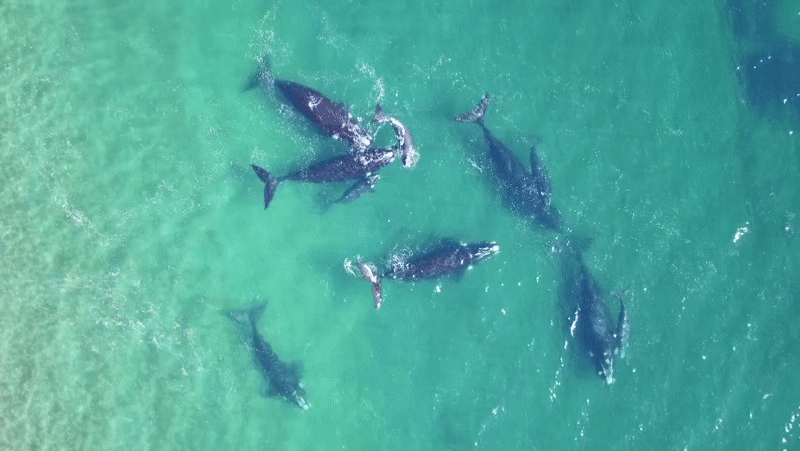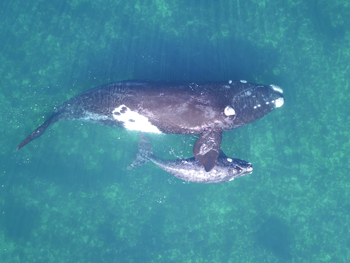Drones help scientists weigh whales at sea
The technology may help evaluate the animals’ health without disturbing them

A drone outfitted with a camera and laser rangefinder captured these images of southern right whales. Scientists used the images to develop a computer program for estimating a whale’s weight. Images/videos taken after getting a research permit.
Fredrik Christiansen at Aarhus Institute of Advanced Studies
Weighing a whale is a beast of a challenge. Scientists who study these majestic mammals can’t just hoist them out of the water and plop them onto some scale. But researchers now have a method to estimate a whale’s weight without disturbing it. The approach uses drone imagery of the animals at sea.
The team described how they did it October 1 in Methods in Ecology and Evolution.
This shows what you can do with technology, says Fredrik Christiansen. A marine biologist, he studies sea life. Christiansen works at the Aarhus Institute of Advanced Studies in Denmark. His team estimated a whale’s weight by determining its length and width from a photo. A whale’s body mass — a measure of how heavy it is for its size — can reveal if it’s underfed. Being underweight can hurt its chances of reproducing and surviving at sea. “By photographing [whales] you can get a snapshot of the … health status,” he says.
His team’s new study provides a “really rigorous” method to calculate a whale’s size, says Jeremy Goldbogen. Goldbogen was not part of the work. A comparative physiologist, he investigates how bodies work by comparing animals. He works at Stanford University’s Hopkins Marine Station. That’s in Pacific Grove, Calif.
Whales can fluctuate in body mass “tremendously,” says Goldbogen. At the beginning of their feeding season, whales start out thin. But they fatten up by feasting on tiny ocean animals such as zooplankton and crustaceans (Krus-TAY-shuns). As they eat, their girth — the distance around their midsection — grows. “Some species, they get impressively girthy,” Goldbogen says.
The whales need those fat stores to survive and reproduce. So sizing up whales is important for conserving these species, he notes. And comparing the weights of whales over multiple years can help scientists track their health.
Whale watchers
Christiansen and his team observed southern right whales (Eubalaena australis) for about three months in Península Valdés. That’s in Argentina. Southern right whales come to this South American spot to breed. The scientists used a drone to photograph 86 different whales. Some were mothers, others were juveniles and calves. The drone carried a laser rangefinder. This tool uses a laser to determine the distance between itself and some other object (here, the whale). With this tool, the researchers were able to convert the photos’ pixels to measurements. The team could then size up the whales’ body length, width and height.

A drone hovering above the whales could easily capture length and width. But height was not so easy. The researchers had to wait patiently until some animals showed their sides. “It’s really quite rare that they roll on their side,” says marine biologist Patrick Miller. He works at the University of St. Andrews in Scotland.
Height turned out to be important for figuring out the shape of these whales. Until now, scientists’ best guess was that whale bodies are roughly cylindrical. A cylinder is basically a stack of circles. But the drone pictures revealed that some parts of whale bodies are more like a smooshed cylinder. If you took cross-sections through a whale, starting at the head and moving to the tail, many of them would look oval. The scientists used this information to estimate a whale’s volume — the amount of space within its body.
The team next turned to historical data to help complete the picture. They looked at records from eight whales captured and killed for research in the 1960s. Those whales had been measured and weighed. The scientists calculated the density (weight divided by volume) of the long-dead whales. This information helped the team relate size to mass in living whales.
The team combined the new knowledge of the whales’ body shapes with the density information. They created a computer program to use measurements from drone photos to then estimate the weight of whales at sea. In the past, this information was hard to get unless the animal had died.
Knowing the size and weight — that body mass — of whales can help biologists better understand these creatures. Body mass relates to the animals’ development. It also plays a role in how they swim and float. It’s even linked to their social interactions, such as mating. Larger animals also seem better equipped to handle threats and environmental stresses.
“To suddenly have this breakthrough to be able to measure their body mass, it’s a game changer,” says Miller. He would like to see similar methods developed for other species of whales. “These researchers came up with an ingenious way to do something that until now hasn’t been possible. Hard problems can be solved with creative thinking.”
This is one in a series presenting news on technology and innovation, made possible with generous support from the Lemelson Foundation.







